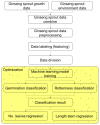Hierarchical Machine Learning-Based Growth Prediction Model of Panax ginseng Sprouts in a Hydroponic Environment
- PMID: 38005764
- PMCID: PMC10675594
- DOI: 10.3390/plants12223867
Hierarchical Machine Learning-Based Growth Prediction Model of Panax ginseng Sprouts in a Hydroponic Environment
Abstract
Due to an increase in interest towards functional and health-related foods, Panax ginseng sprout has been in the spotlight since it contains a significant amount of saponins which have anti-cancer, -stress, and -diabetic effects. To increase the amount of production as well as decrease the cultivation period, sprouted ginseng is being studied to ascertain its optimal cultivation environment in hydroponics. Although there are studies on functional components, there is a lack of research on early disease prediction along with productivity improvement. In this study, the ginseng sprouts were cultivated in four different hydroponic conditions: control treatment, hydrogen-mineral treatment, Bioblock treatment, and highly concentrated nitrogen treatment. Physical properties were measured, and environmental data were acquired using sensors. Using three algorithms (artificial neural networks, support vector machines, random forest) for germination and rottenness classification, and leaf number and length of stem prediction models, we propose a hierarchical machine learning model that predicts the growth outcome of ginseng sprouts after a week. Based on the results, a regression model predicts the number of leaves and stem length during the growth process. The results of the classifier models showed an F1-score of germination classification of about 99% every week. The rottenness classification model showed an increase from an average of 83.5% to 98.9%. Predicted leaf numbers for week 1 showed an average nRMSE value of 0.27, which decreased by about 33% by week 3. The results for predicting stem length showed a higher performance compared to the regression model for predicting leaf number. These results showed that the proposed hierarchical machine learning algorithm can predict germination and rottenness in ginseng sprout using physical properties.
Keywords: ginsenosides; hydroponic cultivation; machine learning; plant factory; rottenness.
Conflict of interest statement
The authors declare no conflict of interest.
Figures











Similar articles
-
Growth and bioactive phytochemicals of Panax ginseng sprouts grown in an aeroponic system using plasma-treated water as the nitrogen source.Sci Rep. 2021 Feb 3;11(1):2924. doi: 10.1038/s41598-021-82487-8. Sci Rep. 2021. PMID: 33536557 Free PMC article.
-
Ginsenoside profiles and related gene expression during foliation in Panax ginseng Meyer.J Ginseng Res. 2014 Jan;38(1):66-72. doi: 10.1016/j.jgr.2013.11.001. Epub 2013 Dec 8. J Ginseng Res. 2014. PMID: 24558313 Free PMC article.
-
Stem-leaves of Panax as a rich and sustainable source of less-polar ginsenosides: comparison of ginsenosides from Panax ginseng, American ginseng and Panax notoginseng prepared by heating and acid treatment.J Ginseng Res. 2021 Jan;45(1):163-175. doi: 10.1016/j.jgr.2020.01.003. Epub 2020 Jan 12. J Ginseng Res. 2021. PMID: 33437168 Free PMC article.
-
Advances in Saponin Diversity of Panax ginseng.Molecules. 2020 Jul 29;25(15):3452. doi: 10.3390/molecules25153452. Molecules. 2020. PMID: 32751233 Free PMC article. Review.
-
Data-driven modeling and prediction of blood glucose dynamics: Machine learning applications in type 1 diabetes.Artif Intell Med. 2019 Jul;98:109-134. doi: 10.1016/j.artmed.2019.07.007. Epub 2019 Jul 26. Artif Intell Med. 2019. PMID: 31383477 Review.
Cited by
-
Efficacy and Safety of Panax ginseng Sprout Extract in Subjective Memory Impairment: A Randomized, Double-Blind, Placebo-Controlled Clinical Trial.Nutrients. 2024 Jun 19;16(12):1952. doi: 10.3390/nu16121952. Nutrients. 2024. PMID: 38931306 Free PMC article. Clinical Trial.
-
Changes in the growth and Lancemaside A content of Codonopsis lanceolata (deodeok) sprouts under LED-based lighting at different red/far-red ratios.Front Plant Sci. 2025 May 28;16:1548781. doi: 10.3389/fpls.2025.1548781. eCollection 2025. Front Plant Sci. 2025. PMID: 40503096 Free PMC article.
References
-
- Kim Y.J., Nguyen T.K.L., Oh M.M. Growth and ginsenosides content of ginseng sprouts according to LED-based light quality changes. Agronomy. 2020;10:1979. doi: 10.3390/agronomy10121979. - DOI
-
- Lee Y.R., Seo J.H., Hong C.Y., Kim K.H., Lee J., Jeong H.S. Antioxidant activities of hydropoic-cultured ginseng roots and leaves. Korean J. Food Nutr. 2020;33:58–63.
Grants and funding
LinkOut - more resources
Full Text Sources

